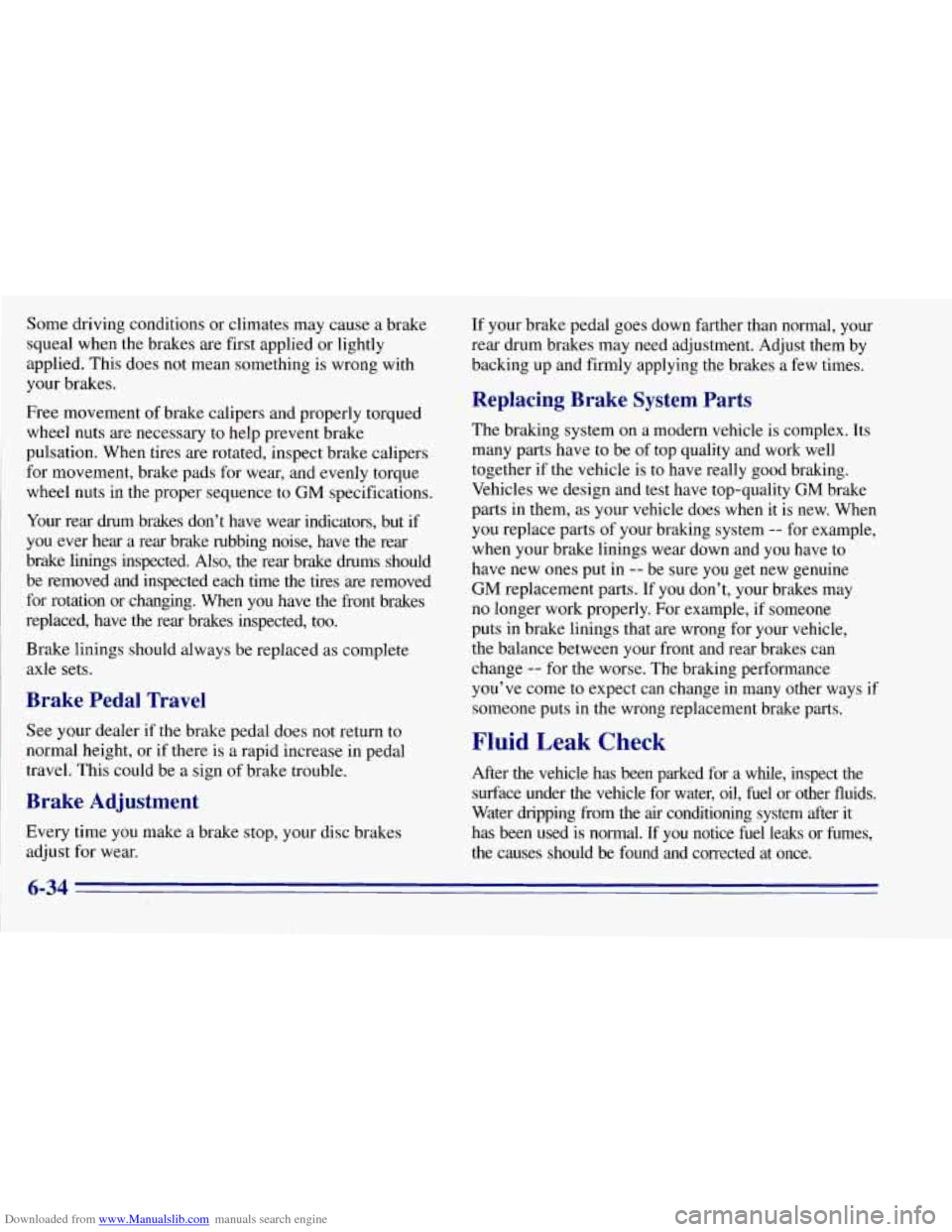1996 CHEVROLET TAHOE height adjustment
[x] Cancel search: height adjustmentPage 287 of 403

Downloaded from www.Manualslib.com manuals search engine Some driving conditions or climates may cause a brake
squeal when the brakes are first applied or lightly
applied. This does not mean something is wrong with
your brakes.
Free movement
of brake calipers and properly torqued
wheel nuts are necessary
to help prevent brake
pulsation. When tires are rotated, inspect brake calipers
for movement, brake pads for wear, and evenly torque
wheel nuts in the proper sequence to
GM specifications.
Your rear drum brakes don’t have wear indicators, but if
you ever hear a rear brake rubbing noise, have the rear
brake linings inspected. Also, the rear brake drums should
be removed and inspected each time the tires are removed
for rotation or changing. When you have the front brakes
replaced, have the rear brakes inspected, too.
Brake linings should always be replaced as complete
axle sets.
Brake Pedal Travel
See your dealer if the brake pedal does not return to
normal height, or
if there is a rapid increase in pedal
travel. This could be a sign of brake trouble.
Brake Adjustment
Every time you make a brake stop, your disc brakes
adjust for wear. If
your brake pedal goes down farther than normal, your
rear drum brakes may need adjustment. Adjust them by
backing up and firmly applying the brakes a few times.
Replacing Brake System Parts
The braking system on a modern vehicle is complex. Its
many parts have to be of top quality and work well
together if the vehicle is to have really good braking.
Vehicles we design and test have top-quality
GM brake
parts in them, as your vehicle does when it is new. When
you replace parts of your braking system
-- for example,
when your brake linings wear down and you have to
have new ones put in
-- be sure you get new genuine
GM replacement parts. If you don’t, your brakes may
no longer work properly. For example, if someone
puts in brake linings that are wrong for your vehicle,
the balance between your front and rear brakes can
change
-- for the worse. The braking performance
you’ve come to expect can change in many other ways if
someone puts in the wrong replacement brake parts.
Fluid Leak Check
After the vehicle has been parked for a while, inspect the
surface under the vehicle for water, oil, fuel or other fluids\
.
Water dripping from the air conditioning system after
it
has been used is normal. If you notice fuel leaks or fumes,
the causes should
be found and corrected at once.
6-34
Page 397 of 403

Downloaded from www.Manualslib.com manuals search engine Replacement Bulbs
................................. 6.68. 6.69
Parts
....................................... 6-71
Wheel
...................................... 6-49
Wheel. Used
................................. 6-50
Replacing the Rear (Third) Seat (Suburban)
.......... I . 16
Reporting Safety Defects
.......................... 8-8
Restraints
Checking
................................... 1-55
Child
........................................ 1-45
Head
........................................ 1-5
Replacing Parts After a Crash
................... 1-56
Systemcheck
................................ 7-43
Reverse. Automatic Transmission
..... ' ............. 2- 15
Right Front Passenger Position
.................... 1-36
Roadside Assistance
.............................. 8-4
Roadside Assistance. Canadian ..................... 8-6
Rocking Your Vehicle
........................... 5-37
Roof Marker Lamp Bulb Replacement
.............. 6-41
Replacing
Safety Belts
........................... 1-56
Rotation. Tires
................................. 6-45
Safety Belts
................................... 1 - 16
Safety
Belt Extender
............................ 1-55
Adults
...................................... 1-21
Care
....................................... 6-55
Center Passenger Position
...................... 1-36
Children
.................................... 1-43
Driver Position
................................ 1-21
Extender
.................................... 1-55
How to Wear Properly ......................... 1-21
Incorrect Usage
.................... 1-24. 1-53. 1-54
LapBelt
.................................... 1-36
Lap-Shoulder
. :. ......................... 1-21. 1-38 Larger Children
.............................. 1-52
Passenger Position
............................ 1-36
Questions and Answers
........................ 1-20
Rear Seat Outside Passenger Positions ............ 1-38
Rear Seat Passengers
........................... 1-38
Reminder Light
......................... 1 - 17. 2-58
Replacing After a Crash ........................ 1-56
Right Front Passenger Position
.................. 1-36
Shoulder Belt Height Adjuster
.............. 1-23, 1-42
Smaller Children and Babies
.................... 1-43
Use During Pregnancy
......................... 1-35
WhyTheyWork
.............................. 1-17
Safety Chains
................................... 4-48
Safety Defects. Reporting
......................... 8-8
Safety Warnings and Symbols. ....................... 111
Scheduled Maintenance Services .................... 7-3
Seatback Latches
...................................... 1-5
Reclining Front
....................... ........ 1-4
Easy Entry (2-Door Utility)
...................... 1-6
Entry to
the Rear (Suburban Second Seat) .......... 1 -13
Folding the Rear (2-Door Utility)
................. 1-8
Folding the Rear (&Door
Utility) ................. 1-9
Folding the Second (Suburban)
.................. 1 -11
Lumbar Adjustment ............................ 1-3
ManualFront
................................. 1-1
Power ....................................... 1-2
Rear
.......................................... 1-7
Removing the Rear (Third) Seat (Suburban)
........ 1 -14
Replacing the Rear (Third) Seat (Suburban)
........ 1 -16
Restraint Systems
.............................. 1-1
Seat Controls ................................. 1-1
Securing a Child Restraint ............ 1-46. 1-48. 1-50
...
Seats
9-8